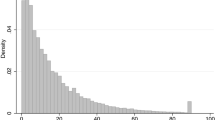Abstract
In this paper, residual demand analysis is applied to test whether carbonated soft drinks is a relevant product market. The residual demand elasticity for carbonated soft drinks is estimated using weekly A.C. Nielsen Scanner price and quantity data for carbonated soft drink products purchased in supermarkets in the United States. The estimated residual demand elasticity and average contribution margin for carbonated soft drinks suggest that a market for carbonated soft drinks is too narrow for purposes of merger analysis according to the Merger Guidelines established by the United States Department of Justice and the Federal Trade Commission.
Similar content being viewed by others
References
Baker, Jonathan B. and Bresnahan, Timothy F. (1984)Estimating the Elasticity of Demand Facing a Single Firm: Evidence on Three Brewing Firms, Research Paper No. 54 (Stanford Workshop on Factor Markets, Department of Economics, Stanford University, Stanford, CA).
Baker, Jonathan B. and Bresnahan, Timothy F. (1988) ‘Estimating the Residual Demand Curve Facing a Single Firm’,International Journal of Industrial Organization 6, 283–300.
Baker, Jonathan B. and Bresnahan, Timothy F. (1985) ‘The Gains from Merger and Collusion in Product Differentiated Industries’,Journal of Industrial Economics 33, 427–444.
Opinion of the Commission,In the Matter of the Coca-Cola Company, Docket No. 9207, June 13, 1994 (“Coca-Cola Decision”).
Opinion of the Commission,In the Matter of the Coca-Cola Bottling Company of the Southwest, Docket No. 9215, August 31, 1994 (“Southwest Decision”).
Kaplan, David P., Tollison, Robert D., and Higgins, Richard S. (1992)The New Learning: Carbonated Soft Drinks and the FTC, Working Paper (Center for Study of Public Choice, Department of Economics, George Mason University).
Landes, William M. and Posner, Richard A. (1981) ‘Market Power in Antitrust Cases’,Harvard Law Review 94, 937–996.
Mueller, Dennis C. (1986)Profits in the Long Run. Cambridge: Cambridge University Press.
Posner, Richard A. (1976)Anti-Trust Law: An Economic Perspective, Chicago: University of Chicago Press.
Scheffman, David T. and Spiller, Pablo T. (1987) ‘Geographic Market Definition Under the DOJ Guidelines’,Journal of Law and Economics 30, 123–147.
Tollison, Robert D., Kaplan, David P., and Higgins, Richard S. (1990)Competition and Concentration, Lexington, MA: D.C. Health.
United States Justice Department of Justice and Federal Trade Commission, Horizontal Merger Guidelines, April 2, 1992.
Author information
Authors and Affiliations
Additional information
Two of the authors, Kaplan and Tollison, have served as consultants to and received research support from PepsiCo, Inc. The present project, though an aoutgrowth of this earlier work, received no support from PepsiCo, Inc. or any other source. The views expressed in the article are soley those of the authors, and the authors are responsible for any errors or omissions.
Rights and permissions
About this article
Cite this article
Higgins, R.S., Kaplan, D.P., Mcdonald, M.J. et al. Residual demand analysis of the carbonated soft drink industry. Empirica 22, 115–126 (1995). https://doi.org/10.1007/BF01384649
Issue Date:
DOI: https://doi.org/10.1007/BF01384649




